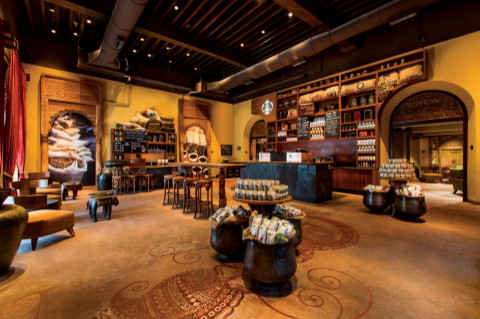Starbucks Corporation Opens First Store In India, With 'Humility'

There were supposed to be 50 Starbucks cafes in India by the end of the year. That number has been cut to three, a rate of expansion that demonstrates just how hard it can be to plant a retail foothold in the subcontinent.
In an elaborate debut on Friday in South Mumbai’s resplendent Horniman Circle, a crescent-shaped esplanade that has become the focal point of international luxury-brand retail, Seattle’s Starbucks Corp. (NASDAQ: SBUX) and desi partner Tata Global Beverages Ltd (BOM: 500800) of Kolkata unveiled the first Starbucks coffee shop in the world’s second-most populated nation.
The 4,000-square-foot, two-level flagship coffee shop was designed to reflect the surrounding 19th-century architecture. Described as the coffee chain’s most elegant and beautiful outlet, it resembles a polished, track-lighted Disney version of a colonial East India Company store.
“We are coming here with humility,” Howard Schultz, Starbucks’ 59-year-old, Brooklyn-born CEO and chairman, told a throng of reporters that had gathered for the occasion.
Humility indeed.
In January, when the Starbucks/Tata joint venture was announced, Starbucks said it would open stores in Delhi and Mumbai by the end of the year. Though they made no estimate in their press announcements, Tata Global Vice Chairman R. K. Krishnakumar reportedly tossed out the 50-store figure at the press conference.
As the end of 2012 approaches, the estimate is off by 47 stores. Next week, the two companies are scheduled to unveil two more Mumbai-based stores, including one in the regal Taj Mahal Palace hotel that was the target of the 2008 Mumbai terrorist attack because of its popularity among wealthy travelers and business executives. The green-siren Starbucks logo that’s so ubiquitous in the U.S. and parts of Asia won’t appear in Delhi this year as announced.
So what’s the problem?
For one thing, it’s India, a massive country with considerable infrastructure challenges. A recent change in the country’s commerce law allows foreign retailers to invest directly in some cities provided they build infrastructure, especially roads and cold-storage facilities that would help reduce the relatively large amount of perishable food that rots before it can get into consumers' hands. In 2011, Canadian property manager Ivanhoé Cambridge ended a three-year effort to develop malls in India largely because of the country’s weak roads and public transportation networks and its failure to find a local partner, as required by law.
Secondly, India’s pace of business development is slow. While setting up business in India isn’t as difficult as it was prior to 1990, the bureaucracy is still enormous. In January, a Hong Kong-based consulting firm rated India’s bureaucracy the worst in Asia, ahead of Vietnam, Indonesia and the Philippines. Bashing Indian government bureaucracy and official graft is practically a national pastime. Starbucks does have an advantage because of Tata’s long experience handling the processes needed to facilitate business in the country, but the system is still time-consuming. Starbucks began the effort to open shop in the country six years ago.
Thirdly, Indians are poor. One of the big challenges for Starbucks in India has been to figure out how to offer price points that would allow it to expand beyond wealthy Mumbai districts. India’s per capita annual income is $1,600 -- two thirds of the country lives on less than $2 per day. By using locally sourced coffee, Starbucks has succeeded in addressing the pricing issue and is able to boast that it's coffee is locally sourced. But if the company succeeds in eventually opening its 3,000th store in India, as it has said it would like to see, it will need a much lower price point than the $4 lattes sold in the U.S. The starting price of a small regular coffee is 85 rupees, or $1.57, according to the New York Times. The cost of a Starbucks coffee in India will likely need to be half what it's priced in the U.S., Saloni Nangia, president at Gurgaon-based consultancy Technopak Advisors Pvt., told Bloomberg.
India has been growing by an average of 8.3 percent in recent years, but it’s also dealing with record-high inflation of 9 percent since 2010. Any large, successful, long-term retail operation in India needs not just economic liberalization and a better network of roads, but also a larger middle-class base of consumption. Until then, Starbucks’ green-siren logo won't bloom outside of where the country’s urban elites reside.
Shares in both companies were down on Friday, Starbucks by 3.9 percent, to $45.56 and Tata Global Beverages by 2.59 percent to 157.90 rupees ($2.93).
© Copyright IBTimes 2025. All rights reserved.





















